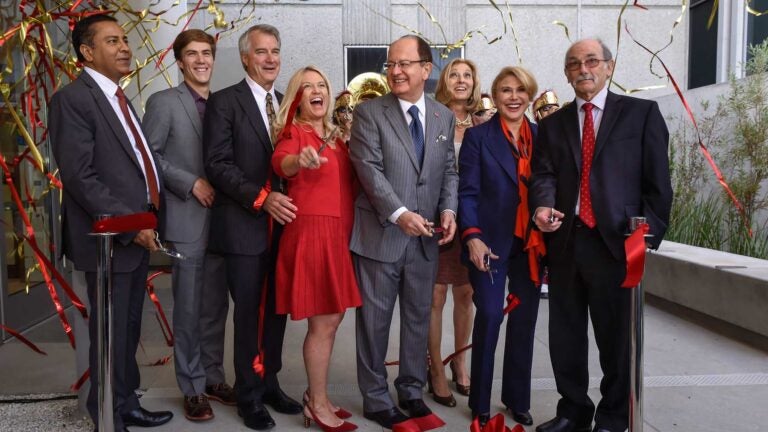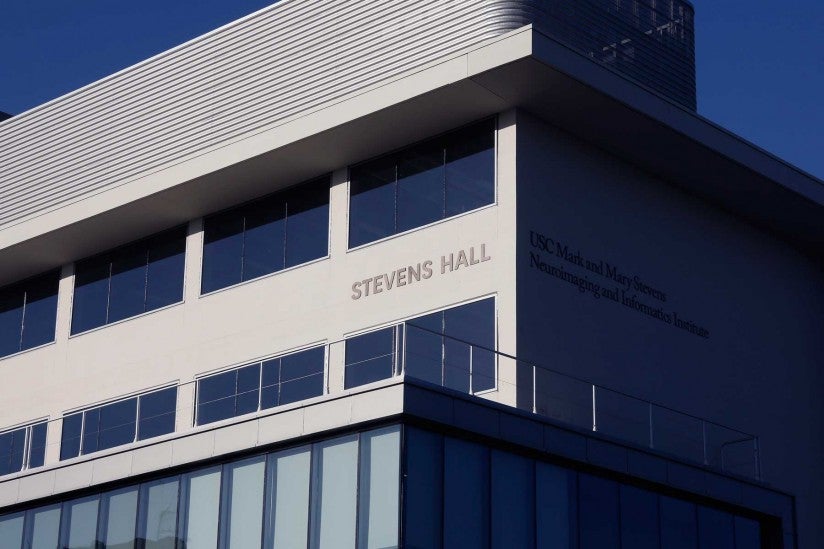
Rohit Varma, Sean Stevens, Mark and Mary Stevens, C. L. Max Nikias, Niki C. Nikias, Ghada Irani and Arthur Toga, from left, attend the opening of the USC Stevens Hall for Neuroimaging. (USC Photo/Gus Ruelas)
USC Stevens Hall for Neuroimaging officially opens its doors
New home for the USC Mark and Mary Stevens Neuroimaging and Informatics Institute represents a step in the fight against neurologic disorders
The USC Stevens Hall for Neuroimaging, a sleek, glass-enclosed building — home to the USC Mark and Mary Stevens Neuroimaging and Informatics Institute on USC’s Health Sciences Campus — opened its doors Thursday.
Just before the formal ribbon-cutting ceremony took place, Arthur Toga, director of the USC Stevens Neuroimaging and Informatics Institute, was installed as holder of the Ghada Irani Chair in Neuroscience.
USC President C. L. Max Nikias stressed how the opening was another significant step being taken toward fighting the most debilitating neurologic disorders of our time.
“Here we can hope to understand autism and Alzheimer’s and a host of other challenges,” Nikias said. “Here we now have an environment in which an electric sense of possibility is ever-present. We can expect to be surprised, as insight and solutions will burst forth in ways we cannot yet imagine.”
Mark and Mary Stevens, USC trustees and benefactors of USC Stevens Hall, were on hand to see the fruition of their commitment to multidisciplinary efforts in scientific innovation. Rohit Varma, dean of the Keck School of Medicine of USC and director of the USC Roski Eye Institute, also celebrated the grand opening and the advancements that could soon arise.
“The research from Dr. Toga and his colleagues at the USC Stevens Neuroimaging and Informatics Institute is exactly the type of forward-thinking, translational research that will drive the Keck School of Medicine’s success,” Varma said. “I am looking forward to the transformative science that will be conducted in this building in the coming years.”
The house that science built

USC Stevens Hall is optimized for the advanced science for which Toga is known. This is because Toga himself designed the building alongside architecture firm SmithGroupJJR. The 35,227-square-foot building, renovated and rehabilitated from the original 1952 concrete frame, is naturally bright, with plenty of California sunshine streaming through glass walls. The main entrance has biometric access control with the ability to read a person’s identification badge, fingerprint or iris pattern.
The interior design features few straight lines, an intentional choice from Toga.
“Straight lines rarely occur in nature,” he noted.
The walls are lined with monitors displaying rotating images of exquisite, brightly colored brain maps. But the most fascinating features of USC Stevens Hall are the ones that will facilitate the USC Stevens Neuroimaging and Informatics Institute’s world-class research:
- The largest brain data repository in the world, currently holding about 3 petabytes of information from every continent except Antarctica.
- A Siemens 3T Prisma MRI machine, with the world’s first and only Siemens 7T MRI coming early next year. To accommodate the machines, the imaging rooms were built with a removable roof hatch so they are accessible by crane.
- The Data Immersive Visualization Environment presentation theater, where researchers can project massive data sets and magnified images on a 12-by-15-foot screen with 1.5 mm pixel display in ultrahigh-definition 4K resolution.
- An on-site, high-performance computing cluster with 4,096 processor cores.
A brain research powerhouse
The USC Stevens Neuroimaging and Informatics Institute, part of the Keck School of Medicine, comprises four groups:
- The Laboratory of Neuro Imaging (LONI), the most prominent face of the institution, is a research enterprise that includes students, faculty and staff with backgrounds in mathematics, physics, computer science and neuroscience. The lab focuses on the creation of three-dimensional digital neuroanatomic and functional neuroanatomic atlases (in layman’s terms, brain maps), which can better equate data from multiple studies and create a database of invaluable information for neuroscientists worldwide.
- The Imaging Genetics Center is a multidisciplinary research team studying the link between genetics and neuroimaging. With the assistance of more than 1,000 collaborators from around the world, the center has contributed more than two decades of advances and discoveries in major brain disorders and diseases, including Alzheimer’s and autism.
- The Center for Image Acquisition, which opened earlier this year, refers to USC Stevens Hall’s MRI facility. The Siemens 3T that is currently in use employs a high-end gradient system that provides the detailed imaging information required for the institute’s research needs. The Siemens 7T MRI system, which will arrive next year, is an investigational device that will be used exclusively for clinical trials.
- The USC Stevens Neuroimaging and Informatics Institute also houses the master’s of science program in neuroimaging and informatics. The one-year, 26-credit program provides in-depth understanding about the science and technology behind neuroimaging and informatics.
The brain’s geography
Toga has long been an acclaimed figure for his brain imaging research. Alongside USC Professor Paul Thompson, Toga is acclaimed for developing advanced algorithms and scientific approaches in neuroimaging, using massive data sets to better understand the brain’s geography in both population-based and disease-specific studies. At the time of the duo’s arrival in 2013, Toga noted that joining the Trojan Family “would invigorate [their] activities considerably.”
Through the efforts of LONI and the IGC, as well as numerous other studies slated at USC Stevens Hall, the university will continue to drive innovation at the point of biotechnology and data analysis.
“I designed every facet of USC Stevens Hall bearing in mind the challenges we face in neuroimaging and the tools my team needs to overcome those challenges,” Toga said. “Through the generosity of Mark and Mary Stevens, we have the ideal environment to enable our research, and you can expect the institute to chip away even faster at the perplexing neurological issues plaguing us today.”



